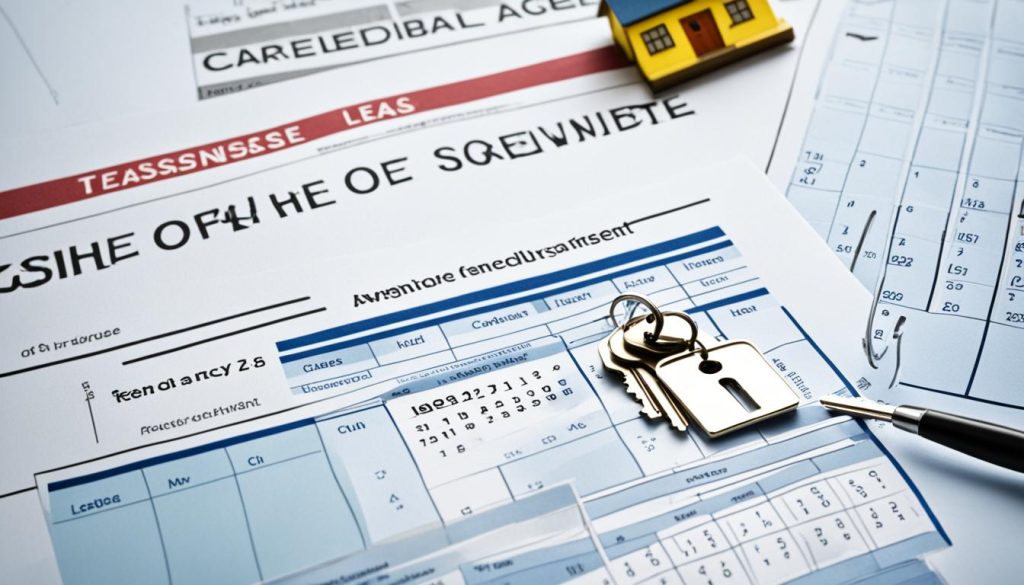A statutory periodic tenancy is a fundamental concept in property law and rental agreements. It arises when a fixed-term tenancy agreement expires and continues on a periodic basis without a new contract being signed. This type of tenancy has important implications for both landlords and tenants, as it establishes their rights and responsibilities during the ongoing lease term. To navigate the complexities of rental agreements and ensure compliance with property law, it is crucial to have a clear understanding of statutory periodic tenancy.
In this article, we will explore the key aspects of statutory periodic tenancy, including landlord rights, tenant rights, lease renewal, and the importance of a well-drafted tenancy agreement. Whether you are a landlord or a tenant, this information will empower you to make informed decisions and effectively manage your rental property.
Types of Periodic Tenancy – Contractual and Statutory
When it comes to periodic tenancies, there are two main types that landlords and tenants should be aware of: contractual periodic tenancy and statutory periodic tenancy.
Contractual Periodic Tenancy
A contractual periodic tenancy is established when the original tenancy agreement includes a specific clause stating that the tenancy will continue on a periodic basis after the fixed term has ended. This means that both the landlord and tenant have agreed in advance that the tenancy will transition into a periodic arrangement. The tenancy agreement will outline the terms and conditions that apply during this period.
An example of a contractual periodic tenancy is the National Residential Landlords Association (NRLA) assured shorthold tenancy agreement. This agreement creates a contractual periodic tenancy, allowing the tenancy to continue on a periodic basis after the initial fixed term.
Statutory Periodic Tenancy
A statutory periodic tenancy, on the other hand, is automatically created when there is no specific clause in the tenancy agreement indicating that the tenancy will continue on a periodic basis. This type of tenancy is governed by Section 5 of the Housing Act 1988.
In a statutory periodic tenancy, the tenancy rolls over into a periodic arrangement upon the expiration of the fixed term without any additional agreement or negotiation. The terms and conditions of the original tenancy agreement still apply, but the tenancy continues on a periodic basis until either the landlord or the tenant provides notice to end the tenancy.
It is important for both landlords and tenants to understand the type of periodic tenancy they are entering into, as it affects their rights and responsibilities. Contractual periodic tenancies are established by mutual agreement, while statutory periodic tenancies are created automatically by the law.
Below is a table summarizing the key differences between contractual and statutory periodic tenancies:
| Key Differences | Contractual Periodic Tenancy | Statutory Periodic Tenancy |
|---|---|---|
| Creation | Tenancy agreement includes a clause indicating continuation on a periodic basis | No specific clause in the tenancy agreement |
| Governing Law | Contractual agreement between landlord and tenant | Section 5 of the Housing Act 1988 |
| Terms and Conditions | Agreed upon in the original tenancy agreement | Based on the terms and conditions of the original tenancy agreement |
| Continuation | Agreed continuation after the fixed term | Automatic rollover after the fixed term |
Understanding the distinction between contractual and statutory periodic tenancies is crucial for landlords and tenants to make informed decisions and navigate the complexities of rental agreements effectively.
Termination of Periodic Tenancy
The termination process for a periodic tenancy differs depending on whether it is a contractual or statutory periodic tenancy. Understanding the correct notice periods is crucial for both landlords and tenants to effectively end the tenancy.
Statutory Periodic Tenancy Termination
In a statutory periodic tenancy, the tenant must provide a minimum of one month’s notice if the rent was paid monthly, or four weeks’ notice if the rent was paid weekly. This notice period allows the tenant to inform the landlord of their intention to terminate the tenancy.
It is important for tenants to adhere to the notice period specified in the agreement to ensure a smooth termination process.
On the other hand, the landlord must serve a minimum of two months’ notice to the tenant using a Section 21 notice. This notice informs the tenant of the landlord’s intention to terminate the tenancy. The Section 21 notice must be in writing, clearly stating the date on which the notice is given and the date on which the landlord requires possession of the property.
Landlords should ensure that the Section 21 notice is served in compliance with the legal requirements to avoid any complications in the termination process.
Contractual Periodic Tenancy Termination
For a contractual periodic tenancy, the termination notice period is typically determined by the original contract. Both the landlord and the tenant must adhere to the notice period specified in the agreement to effectively end the tenancy.
It is essential for both parties to review the original contract to understand the exact notice period required for termination.
During the termination process, open communication between landlords and tenants is crucial for a smooth transition. Clear understanding of the notice period and compliance with the termination procedure will help minimize any disputes or complications.

| Termination | Statutory Periodic Tenancy | Contractual Periodic Tenancy |
|---|---|---|
| Notice Period | Minimum one month’s notice if rent paid monthly. Minimum four weeks’ notice if rent paid weekly. |
Determined by the original contract |
| Landlord Notice | Minimum two months’ notice using a Section 21 notice | Depends on the original contract |
Rent Increase in Periodic Tenancy
Rent increases in periodic tenancies can vary depending on whether the tenancy is statutory or contractual. Understanding the process for rent increases is essential for both landlords and tenants.
For a statutory periodic tenancy, the landlord can propose a rent increase immediately after the fixed term has ended. This can be done by serving a section 13 notice to the tenant, as outlined in the Housing Act 1988. The notice period for the increase will vary depending on the frequency of rent payments. If the rent is paid monthly, the notice period is usually one month. If the rent is paid weekly, the notice period is generally four weeks.
On the other hand, for a contractual periodic tenancy, the rent increase may already be specified in the original contract. In this case, the landlord can simply notify the tenant of the increase and follow any specific procedures outlined in the contract. If the original contract does not include a rent increase provision, the landlord can still propose a rent increase by following the guidelines set out in the Housing Act 1988, similar to a statutory periodic tenancy.
It’s important for landlords to be aware of the legal requirements and procedures when proposing a rent increase. Tenants should also understand their rights and any obligations they may have in response to a rent increase.

To summarize, both statutory and contractual periodic tenancies have their own processes for rent increases. Landlords must adhere to the rules set out in the Housing Act 1988 and serve the appropriate notices to tenants. Tenants, on the other hand, should familiarize themselves with their rights and responsibilities regarding rent increases. By understanding the specifics of rent increases in periodic tenancies, both landlords and tenants can ensure a fair and transparent process.
Council Tax Liability in Periodic Tenancies
When it comes to council tax liability, there are important differences between statutory periodic tenancies and contractual periodic tenancies. Both landlords and tenants should have a clear understanding of their obligations in order to avoid any misunderstandings or disputes.
Statutory Periodic Tenancy and Council Tax Liability
In a statutory periodic tenancy, the tenant is only liable for council tax during the period they live in the property. This means that if they decide to move out before the end of the notice period, their council tax liability ends when they vacate the property. This can be beneficial for tenants who need flexibility and may need to move out before the notice period expires. However, it is important to note that the tenant is still responsible for paying council tax for the period they lived in the property.
Contractual Periodic Tenancy and Council Tax Liability
A contractual periodic tenancy works differently when it comes to council tax liability. In this type of tenancy, the tenant is responsible for paying council tax for the entire notice period, even if they choose to leave the property before the notice period ends. This means that tenants who move out before the notice period expires are still liable for council tax until the end of the notice period. Landlords may include this clause in the tenancy agreement to ensure that they are not left responsible for council tax payments if the tenant decides to vacate the property early.
It is crucial for both landlords and tenants to understand their council tax obligations during a periodic tenancy. Clear communication and proper documentation, such as a detailed tenancy agreement, can help avoid confusion and potential disputes. If there are any questions or concerns regarding council tax liability, seeking professional advice from a legal expert or local council can provide clarity and ensure compliance with the necessary regulations.
Council Tax Liability Summary
| Tenancy Type | Council Tax Liability |
|---|---|
| Statutory Periodic Tenancy | Liable for council tax during the period of residence; liability ends when the tenant moves out before the end of the notice period |
| Contractual Periodic Tenancy | Liable for council tax for the entire notice period, even if the tenant moves out before the end of the notice period |
Understanding council tax liability is an important aspect of managing a periodic tenancy. Both landlords and tenants should be aware of their rights and responsibilities to ensure a smooth and compliant tenancy. By staying informed and communicating effectively, both parties can navigate the complexities of council tax liability with confidence.
Key Differences and Considerations for Periodic Tenancies
Periodic tenancies can come in different forms, including contractual and statutory. Understanding the key differences and considerations between these types of tenancies is important for both landlords and tenants to ensure smooth and compliant rental agreements.
Termination Process
In a contractual periodic tenancy, the termination process is determined by the original agreement. The notice period and procedure for ending the tenancy should be clearly stated in the contract. It is crucial for both parties to follow the agreed-upon termination process to avoid any legal disputes.
On the other hand, a statutory periodic tenancy follows specific rules outlined in the Housing Act 1988. To terminate this type of tenancy, the landlord must provide a minimum notice period of two months using a section 21 notice. The tenant, on the other hand, is typically required to provide at least one month’s notice if the rent is paid on a monthly basis.
Rent Increase Procedures
When it comes to rent increases, the procedures can differ between contractual and statutory periodic tenancies. For a contractual periodic tenancy, the original agreement should specify how and when rent increases can occur. Landlords must adhere to the terms set out in the contract.
In a statutory periodic tenancy, the landlord can propose a rent increase by serving a section 13 notice to the tenant. The notice period for the increase varies depending on the rental payment frequency. It is essential for landlords to follow the correct procedures and provide adequate notice when proposing a rent increase.
Council Tax Liability
The responsibility for council tax liability is another area where contractual and statutory periodic tenancies can differ. In a statutory periodic tenancy, the tenant is only liable for council tax during the period they occupy the property. If the tenant moves out before the end of the notice period, their liability for council tax ends when they vacate.
However, in a contractual periodic tenancy, the tenant is usually responsible for paying council tax for the entire notice period, even if they vacate the property before the notice period expires. It is important for both landlords and tenants to be aware of their council tax obligations in accordance with the type of periodic tenancy they have.
NRLA Agreement and Obligations
For landlords who use the NRLA (National Residential Landlords Association) assured shorthold tenancy agreements, certain obligations and requirements apply to both contractual and statutory periodic tenancies. These agreements outline the rights and responsibilities of both landlords and tenants, ensuring a fair and transparent rental relationship.
Landlords should familiarize themselves with the NRLA agreement and the obligations it imposes, such as maintaining the property’s condition, providing necessary repairs, and adhering to safety regulations. Tenants, on the other hand, are obligated to pay rent on time, report any repairs or issues promptly, and follow the tenancy agreement’s terms and conditions.

Understanding the key differences and considerations for both contractual and statutory periodic tenancies is crucial for both landlords and tenants. By being well-informed about the termination process, rent increase procedures, council tax liability, and the obligations outlined in the NRLA agreement, both parties can ensure a smooth and compliant tenancy.
Conclusion
Periodic tenancies provide a flexible option for both landlords and tenants, allowing them to navigate the complexities of rental agreements. However, it is important to remember that periodic tenancies are subject to specific rules and regulations that must be followed.
In order to make the most informed decisions, landlords and tenants should carefully consider the type of periodic tenancy that best suits their needs. This includes understanding their rights and responsibilities under the rental agreement.
Seeking legal advice is always advisable to ensure compliance with housing regulations and to navigate any potential complexities that may arise during a periodic tenancy. By doing so, both landlords and tenants can safeguard their rights and ensure a smooth and successful renting experience.
FAQ
How long can a statutory periodic tenancy last?
A statutory periodic tenancy, also known as a rolling tenancy, can last for an indefinite period of time as long as both the landlord and tenant agree to it. However, if either party wants to end the tenancy, they must give the other party proper notice according to UK property laws. Generally, this notice period is at least 2 months for tenants and 2 months or more for landlords, depending on the circumstances.
Can a landlord increase rent on a statutory periodic tenancy?
Yes, a landlord can increase rent on a statutory periodic tenancy, but there are specific guidelines that must be followed. Under the law, landlords must provide at least one month’s notice before increasing the rent, and the increase cannot take effect until the end of the agreed-upon rental period.
How do you terminate a statutory periodic tenancy?
Terminating a statutory periodic tenancy can be done through giving proper notice to the tenant. In the UK, this requires giving at least one month’s written notice, which must align with the end of a rental period as stated in the tenancy agreement. It is important to follow the correct procedures and timelines to avoid any legal complications. Our platform, UK Property News, provides valuable resources and guidance for landlords and tenants on all aspects of tenancy agreements and terminations.
What is a Section 13 notice for statutory periodic tenancy?
A Section 13 notice for statutory periodic tenancy is a legal document that landlords in the UK must provide to their tenants if they wish to increase the rent. This notice must be given at least one month before the proposed increase and must include the new rental amount, the date it will come into effect, and any changes to the tenancy contract. It is an important part of the renting process and ensures that both landlords and tenants are on the same page regarding any changes in rent prices.






